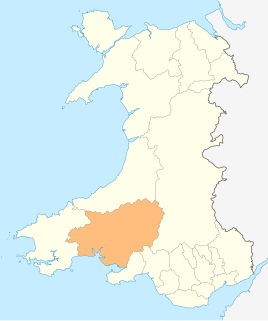
The Honourable Society of Cymmrodorion, often called simply the Cymmrodorion, is a London-based Welsh learned society, with membership open to all. It was first established in 1751 as a social, cultural, literary and philanthropic institution. It fell into abeyance between 1787 and 1820, and again between 1843 and 1873. In its second and third incarnations its interests have been predominantly cultural and antiquarian. The present society claims continuity from that founded in 1751, although the three successive societies have in fact been slightly different in character and aims.
Thomas Bowles was a Church of England priest. He is notable for a controversy in which he was appointed to two parishes in Wales where hardly any parishioners spoke English, despite the fact that Bowles spoke no Welsh. Bowles was a grandfather of the priest and poet William Lisle Bowles (1762–1850).

John Egerton was a Church of England bishop from the Egerton family. He was consecrated Bishop of Bangor in 1756 and translated to Lichfield in 1768. He was translated again in 1771 to become Bishop of Durham, which see he held until his death in 1787.
This article is about the particular significance of the year 1819 to Wales and its people.

St David's School was an independent girls' school in Ashford, England. The school was originally established in London in 1716 as the British Charity School or Welsh Charity School, and moved to Ashford in 1857. It was at first a boys' school, and then from 1758 co-educational, but from 1882 it began to admit girls only and became known as the Welsh Girls’ School. It changed its name to St David's School in 1967, and closed in 2009.
John Jenkins was a Welsh priest in the Church of England and an antiquarian. He played a leading role in the establishment of eisteddfodau in Wales in the nineteenth century.
Robert Thomas Jenkins CBE was a Welsh historian and academic.
Y Cymmrodor was the annual journal of the Honourable Society of Cymmrodorion, published between 1821 and 1951. It contained essays and lectures on historical and literary topics and Welsh poetry.
The Dictionary of Welsh Biography (DWB) is a biographical dictionary of Welsh people who have made a significant contribution to Welsh life over seventeen centuries. It was first published in 1959, and is now maintained as a free online resource.
The Gwyneddigion Society was a London-based Welsh literary and cultural society. The original society was founded in 1770 and wound up in 1843. It was briefly revived in 1978. Its proceedings were conducted through the medium of Welsh.
The Honourable and Loyal Society of Antient Britons was a London-based Welsh social, cultural, and philanthropic society, which was in existence from 1715 until the end of the 18th century.
Saint Gwrddlew or Gwrtheli, Gartheli, was a pre-congregational saint of the 5th century medieval, Wales.
Saint Gwrfyw, was a pre-congregational saint of medieval Wales.

Ystrad Marchell sometimes Strad Marchell was a medieval commote (cwmwd) in the cantref of Ystlyg in the Kingdom of Powys. It roughly coincides with the parish of Welshpool.
Siôn Abel, also known as John Abel, was a Welsh balladeer and teacher who lived in Montgomeryshire.
Thomas Baddy was an Independent minister and author.

St Cwyfan's Church is a Grade II*-listed medieval church in Llangadwaladr, Anglesey, Wales. Located on the small tidal island of Cribinau, it is popularly known as the "Church in the Sea". The church dates from the 12th century, with some renovations made in the 19th century.
David Davies was a Welsh Independent minister, and editor of 'Y Geirgrawn'. He is thought to have grown up in the Llanybydder area, Carmarthenshire. He is known to have been studying at the Academy in Swansea in 1786. By 1787 however, he was ordained and pastor of the church at Pen-y-Graig and of Capel Sul, Kidwelly. He subsequently moved to Holywell, where he stayed until 1800. It was there he published his radical magazine 'Y Geirgrawn'. Its controversial views are known to have caused upset amongst the authorities and his congregation, to the extent that surviving letters on the subject speak of ‘unhappy misunderstandings’ which ‘went on for years’. On leaving Holywell in 1802 he moved to Welshpool, and then, in 1803 to Stoneway, Bridgnorth.
Howel Davies was a Welsh Methodist minister. Little is known about his early life, but by 1737 he is known to have been a schoolmaster at Talgarth. There he was converted by Howel Harris, and on his advice went to Llanddowror to study under Griffith Jones. In 1739 he was ordained deacon, and then a priest in 1740. serving initially at the church in Llandilo Abercowin, before moving in 1741 to Llys y Fran, Pembrokeshire. Along with Harris and Jones, he made a major contribution to the spread of Calvinistic Methodism in Pembrokeshire, so much so that he became known as "the Apostle of Pembrokeshire".
John Davies was a Welsh Unitarian minister, and schoolmaster. His father was David Davies, minister of Llanybri. John Davies received some early education at home, his father being a notable Classical and Hebrew scholar. He later attended a local grammar school, and Carmarthen Academy (1815–19), where his father had taught. Having became a member of the Unitarian Church whilst at college, he began preaching at the local chapel. Later, following the retirement of David Davis of Castell Hywel in 1820, he took charge of the churches of Alltyblaca, Bwlchyfadfa, Llwyn-rhyd-Owen, and Pen-rhiw. He also worked as an assistant at the grammar school run by Davis, before starting schools of his own at Gelli-gron, Blaenbydernyn, Tyssul Castle, and Tre-fach, and, in 1830, an academy at Adpar, Newcastle Emlyn. His pupils included the antiquary Thomas Stephens.







